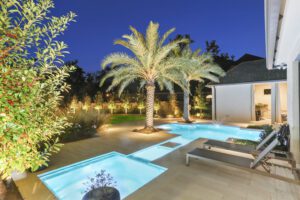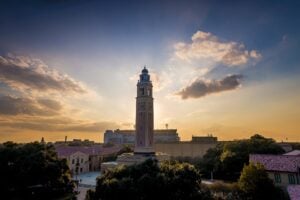An evolving oasis – In the heart of the city, the Burden Museum Gardens is blossoming anew
There’s a serene little spot near the head of the trail that darts off behind the orangerie at Burden Museum & Gardens. Here, past the first swath of trees with ethereal names like winged elm and water oak, near the wooden bridge that stretches over a barely damp creek, lies the fallen cross section of a storm-struck hardwood. A portion of the trunk’s bark has been neatly hewn to provide a smooth surface for sitting, a perfect place to soak in the sunlight that filters through the canopy and to hear the hidden birds chirp and warble in an avian symphony.
Though more dazzling attractions exist on this 440-acre property, this is just the sort of simple setting Steele Burden and his family wanted to see preserved when they began donating the land to LSU in 1966. Steele and his sister Ione, along with the widow of their brother Pike, insisted that the wooded tracts remain natural wildlife areas, even as the rest of the acreage became fertile ground for horticultural research and public enjoyment.
Nearly 50 years after the Burdens’ grand gesture, the land they loved is thriving. Much is the same as they left it. But gradually, thoughtfully, the facility’s leaders are guiding an evolution that promises to attract even more lovers of Louisiana history and its landscapes than ever before. One of the most visible signs of that progress came last fall, when university officials announced a new unified identity that ties together the property’s three distinct parts: the LSU Rural Life Museum, the LSU AgCenter Botanic Gardens and Windrush Gardens. The newly branded Burden Museum & Gardens highlights the collaboration of these entities while clearing up a little confusion.
“Baton Rouge had never really understood what Burden was,” says LSU AgCenter Botanic Gardens Director Jeff Kuehny. “Some people knew about the Rural Life Museum, but the rest they were unsure about. So we decided, with the Burden Foundation and LSU A&M and the LSU AgCenter, that we needed to figure out a way to make this property a more unified destination so that the public could more easily understand what was available and what to expect.”
The revelation of the property’s new name coincided with the launch of new initiatives both at the Rural Life Museum and at the Botanic Gardens. On the gardens side, Kuehny and his team are guided by a master plan completed in 2009, with their sights set on adding more specialty gardens and refining those already in place, which highlight roses, camellias and ornamental ginger. New plots already installed include an All-America Selections display garden featuring vegetables and flowering plants that are being tested around the country, as well as a colorful children’s garden that serves as a model for schools and other community organizations. The plan also calls for a healing and therapy garden that would draw on the property’s close ties to the medical community; such a garden might feature medicinal plants, a labyrinth and quiet spots for meditation.
Changes are also afoot in the Botanic Gardens’ Trees and Trails program, which welcomes schoolchildren and the public to trek along five miles of trails that snake around the property. Construction has begun on a pavilion at the trailhead that will serve as an open-air classroom and event space, and the boardwalk over the Black Swamp will soon be extended. Also in the works, as fundraising campaigns are completed, are a new visitors center at the property’s entrance and a “Big Tree House” that will let visitors ascend into the outstretched arms of hardwood trees as they learn more about this unique habitat.
“We feel like this is going to be a very unique place as we growa place that will become more and more of a destination for our region,” Kuehny says.
Meanwhile, the Rural Life Museum is building on the reputation it has already earned as one of the state’s most unique history-minded destinations. Given its name and vision expressed by Steele Burden himself 44 years ago, the museum serves to “preserve elements of the history of the working class, both free and slave, of rural Louisiana in the 18th, 19th and early 20th centuries,” says David Floyd, who has served as its director for 20 years. “We interpret the lives of these folks through the buildings they lived in and worked with, their vernacular architecture, and we have the largest collection of Louisiana house types in the state. Then we have the largest collection of material culture, things that have a clear provenance to families and farms and plantations in Louisiana.”
With a million-dollar fundraising campaign just completed, museum officials are in the process of installing new introductory exhibits in the visitors center to give guests a clearer picture of the life of early working-class Louisianans. The permanent exhibits will focus on plantation life, the yeoman farmer, slavery in rural Louisiana, the Civil War and Reconstruction, and the Industrial Revolution. “These will give you a preface to what you’re about to experience outside,” Floyd says, alluding to the growing complex of buildings rescued from real-life plantations and early settlements.
“We’re stewards of Louisiana’s history, and as a result, we’re also serious preservationists,” Floyd says. “We do not move buildings for the sake of moving them. They have to be endangered. So all 36 buildings on this property are orphans: If LSU had not moved them and brought them here, they would have been destroyed.”
The museum’s experts are also beginning to take their knowledge further afield. Floyd and a team of archaeologists recently completed an excavation at the site of Chatsworth Plantation, located off River Road near L’Auberge Casino, where they unearthed artifacts ranging from medicine bottles to toys that give a peek at the lives of slaves in the 1800s. In partnership with the casino company, the museum plans to produce traveling exhibits of their finds that could go to universities and libraries around the state.
“It’s just a natural for the Rural Life Museum to head this up, simply because we have the three-dimensional evidence of it still here,” Floyd says. “You know, it’s all about education and trying to understand our past. So this is something we’re excited about.” He adds that the work is continuing at another nearby historic home called Longwood, where museum staffers have been instrumental in preserving “the last Classic Revival antebellum plantation house on the Mississippi River in East Baton Rouge Parish.”
The museum is also unveiling new structures and artifacts in its on-site collection. One of the most recent installations was an 1845-built slave pen from Tally-Ho Plantation in Bayou Goula, one of only a dozen remaining in the United States, and an assortment of Acadian and Creole furniture from Darby Plantation in Baldwin that dates to between 1800 and 1830.
“Steele Burden designed this museum in such a way that it was accessible to the public, to the visitors,” Floyd says. “There’s not a glass wall and people like that. They really feel a connection with the items and the history.”
For both the Botanic Gardens and the Rural Life Museum, public support is key to their success. A host of horticultural organizations call this place home and have a vested interest in its well-being, from local camellia, herb, orchid and bonsai societies to the Burden Horticultural Society, the East Baton Rouge Master Gardeners, Slow Food Baton Rouge and the Capital Area Beekeepers Association. “We have many, many organizations that have a true love of plants; and through their support, both monetarily and through volunteerism and educational programming, we’re able to implement some exciting new things,” says Kuehny.
Even with the excitement of new developments, Burden Museum & Gardens officials are committed to staying true to the vision of the family who wanted to share their picturesque land with all Louisianans.
“They wanted Baton Rouge to love this place as much as they did,” Floyd says. “You get off that crazy Essen Lane and I-10, and after the first three minutes on the place you just kind of decompress. We hear it all the time. So I think that’s just an unbelievable asset for Louisiananot just Baton Rouge.”
A visit to the Burden Museum & Gardens can fill a whole day if you let it. Here are a few of the must-see attractions on the property, some time-tested and others brand new:
For decades the main attraction on the Burden land, this unique museum invites visitors to get an up-close sense of life in Louisiana more than a century ago, from the exhibit barn filled with artifacts to an elaborate complex of furnished historic buildings, including slave cabins and a blacksmith’s shop. Special events like Harvest Days each fall and period-authentic holiday celebrations attract history buffs from around the state.
Designed by Steele Burden in a style he would later echo on the campus of LSU, where he oversaw the landscaping, Windrush features live oak allees and symmetrical layouts inspired by the gardens of Europe. The grounds are divided into distinct garden rooms, each with their own unique look and feel. Also on-site are Windrush House, built in the mid-1800s in the Creole vernacular architectural style, and a hostler’s house that also dates to the 19th century.
At about an acre in size and featuring 13 separate beds of blooms, the Rose Garden is one of the AgCenter’s most visible achievements here and is used for research as well as visitors seeking to pause and take in their surroundings. Once home to only hybrid tea roses, the garden is now being revamped to also reflect modern gardeners’ taste for lower-maintenance varieties like drift and shrub roses.
An alligator carved from fallen trees splays itself across a flowerbed. Colorful dishes border a butterfly-shaped garden plot. Playful delights abound in the new Model School/Children’s Garden, one of the first areas visitors see when they arrive on the property. On a third of an acre, kids are encouraged to touch, smell and explore plantings that attract butterflies and others that are good to eat. The garden changes with the seasons, so every visit is different.
This recent winner of a national award for garden design features new flowers and vegetables being trialed around the country for garden performance. Researchers here watch these plants closely to see how they do in our climate, and their results might just affect what’s in our home gardens a year or two down the road.
Modeled after conservatories used to protect citrus trees in winter, the orangerie was the last building designed by Burden’s close friend A. Hays Town and is today used for special events. “Steele was one of the most wonderful men I’ve ever known,” said Town. “He had a great talent, and I learned a great deal from him. I’m a whole lot smarter because of him.”
Steele Burden created the earliest version of the five miles of trails here as his own meandering footpaths through the Burden Woods. Today, the trails feature educational signs explaining the flora and fauna and offer excellent vantage points for birdwatchers. Even as they preserve this original landscape, Burden officials are keeping apace with the times; they plan to add QR codes to signs and maybe even an app with trail information in the near future.
At the rearmost point of the trail network lies this pristine tupelo tree-studded swamp that is “at least 200 years old and probably much older than that,” says Jeff Kuehny. “It’s really an incredible area that’s been preserved.” The swamp gets its name from the dark hue that the water takes on when colored by the tannins in the fallen leaves. The boardwalk that extends over the water will soon connect to another little-known Burden property attraction, the Barton Arboretum.
About five acres are devoted to this hidden gem, a Steele Burden-designed garden spectacle that features a palmetto collection and a variety of native tree species. As the Botanic Gardens staff expands its camellia collection, many of those specimens will find a new home here.











